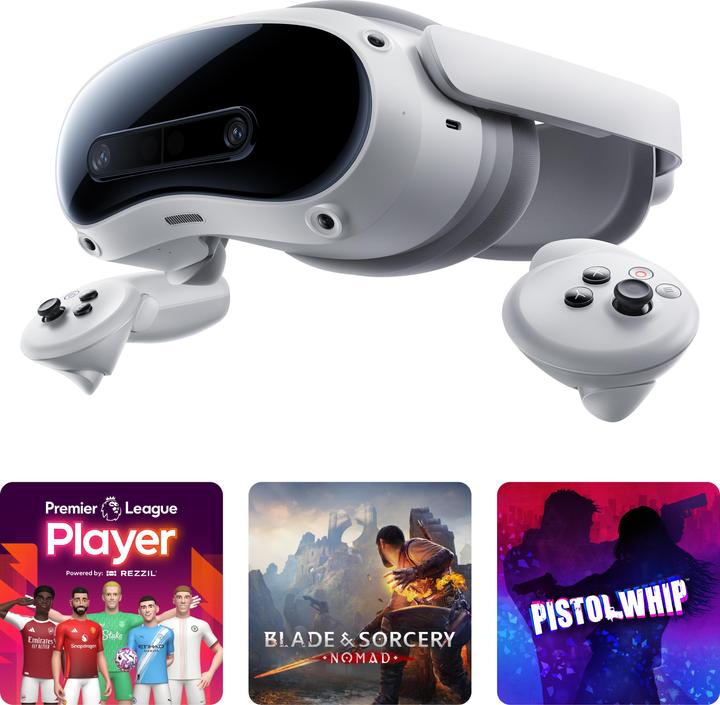
Too Many VR Headsets? How to Find the Right One
Here are five key factors to consider when choosing the best VR headset for your needs.
Last updated 1 week ago. Automatically generated content.


Select options and limit the number of products
Screen technology in a VR headset determines how images are displayed, directly affecting visual clarity, color quality, and overall immersion. Choosing the right screen type influences comfort, realism, and how natural virtual environments appear during use.
Popular options (you can select more than one)
OLED
Uses self-lighting pixels to deliver deep blacks, vibrant colors, and high contrast.
Ideal for immersive experiences with rich visuals, especially in dark scenes or games that benefit from high contrast.
Bestseller
LCD
Employs a backlit panel to produce bright images with minimal risk of screen burn-in.
Offers better brightness and often a more affordable option, making it well-suited for longer play sessions and general use.
Bestseller
Field of view (FOV) measures how wide an area you can see through a VR headset, impacting your sense of immersion and peripheral awareness. A larger FOV creates a more natural and engaging experience, making virtual environments feel closer to real life.
Popular options
90 - 99 °
Typical price
400,– to 640,–Offers a relatively narrow viewing angle, showing less of the virtual environment at once.
Best for basic VR experiences or users who are less concerned about immersion and more focused on simple applications.
Bestseller
100 - 119 °
Typical price
260,– to 840,–Provides a moderate field of view, balancing immersion with hardware comfort and performance.
Suitable for most users, offering a good mix of visual coverage and accessibility for gaming or multimedia.
Bestseller
120 - 140 °
Typical price
520,– to 1800,–Delivers a wide viewing angle, closely matching the human field of vision for a more immersive experience.
Ideal for users who want maximum immersion, such as for advanced gaming, simulations, or professional VR applications.
Bestseller
Refresh rate refers to how many times per second the VR headset's display updates its image, measured in hertz (Hz). A higher refresh rate provides smoother visuals and can reduce motion blur or discomfort, making VR experiences more comfortable and immersive, especially during fast-paced actions.
Popular options
90 - 99 Hz
Typical price
640,– to 1400,–Displays are updated 90 to 99 times per second, offering a basic level of smoothness for most VR games and apps.
Sufficient for casual users and shorter play sessions, helping to minimize motion sickness compared to lower refresh rates.
Bestseller
100 - 119 Hz
Typical price
840,– to 840,–Delivers a higher refresh rate for noticeably smoother motion and reduced image stutter.
Ideal for users seeking better comfort and clarity, especially during action games or longer VR sessions.
Bestseller

Oculus Meta Quest 3 Virtual reality system, 512GB, White, Asgard's Wrath 2 bundle
512 GB
120 - 140 Hz
Typical price
400,– to 750,–Provides very high refresh rates that deliver ultra-smooth visuals and minimal motion blur.
Best for demanding users or competitive gaming, offering the most comfortable and immersive VR experience available.
Bestseller
Storage capacity refers to the amount of internal memory available on a VR headset for apps, games, and media. Choosing the right storage size is important because it affects how many titles and experiences you can keep installed and access without needing to delete or manage files frequently.
Popular options
128 - 128 GB
Typical price
440,– to 840,–Provides basic storage for a limited selection of apps, games, and media files.
Best for occasional users or those who focus on a few core titles, but may require regular file management if you install large games or videos.
Bestseller
129 - 256 GB
Typical price
420,– to 1000,–Offers moderate storage for a wider range of VR content, including several large games and media files.
A balanced choice for most users, allowing you to enjoy multiple experiences without deleting content frequently.
Bestseller
257 - 512 GB
Typical price
570,– to 840,–Delivers ample space for a large library of high-quality games, apps, and offline videos.
Ideal for enthusiasts or households with multiple users, minimizing the need for storage management and supporting large downloads.
Bestseller
The brand of a VR headset shapes user experience through hardware quality, ecosystem, and content support. Leading brands like Meta, Sony, and HTC differ in platform compatibility, exclusive titles, and hardware focus, helping users match the device to their needs and preferred gaming or productivity setups.
Popular brands (you can select more than one)
Meta
Recognized for standalone, wireless headsets with strong app libraries and accessible pricing.
Ideal for first-time users and those wanting an all-in-one VR system without a PC or console.
Bestseller
Sony
Offers headsets designed for seamless integration with PlayStation consoles and exclusive games.
Suited for console gamers seeking high visual fidelity and curated VR experiences.
Bestseller

Sony Playstation VR2
HTC
Known for advanced PC VR headsets with precise tracking and modular options.
Preferred by enthusiasts and professionals who value performance, customization, and SteamVR support.
Bestseller

HTC Vive Focus Vision Consumer Edition + Vive Wired Streaming Kit Virtual Reality Glasses Black 128 GB
128 GB
Pimax
Specializes in wide field-of-view and high-resolution PC VR headsets.
Best for users seeking an immersive, high-end experience in simulation or creative applications.
Bestseller
Renkforce
Focuses on entry-level VR options at budget-friendly prices.
Good for basic VR experiences, educational use, or those exploring VR for the first time.
Bestseller


